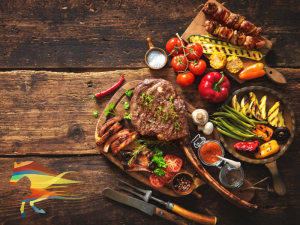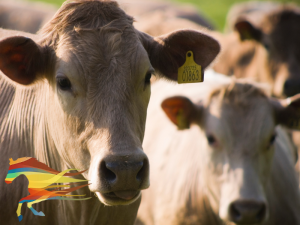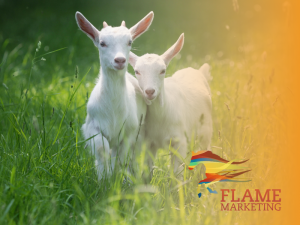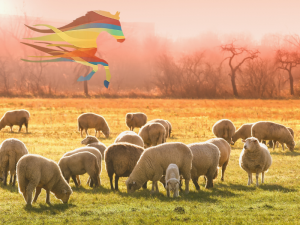

Meat box businesses are a great farm diversification option, particularly as they can be as big or as small scale as you need them to be. This means they are a popular choice for smallholders and farmers alike. Meat boxes offer a direct-sale option that can work for a smallholder who does a few boxes a year or a commercial livestock farmer who does 100 boxes per week. But to get the most from these direct sales, you need to have a clear farm marketing strategy that is suited to your scale and specific needs.
farmers alike. Meat boxes offer a direct-sale option that can work for a smallholder who does a few boxes a year or a commercial livestock farmer who does 100 boxes per week. But to get the most from these direct sales, you need to have a clear farm marketing strategy that is suited to your scale and specific needs.
Regardless of the type of meat box you offer, the key to success is selling the boxes before the meat even goes to slaughter. By doing this, you reduce the risk of having to freeze meat to sell as frozen, which is less popular and ensure you cover your slaughtering costs.
But to do this, you need to build strong customer relationships. Creating strong customer relationships can take time, but one option to speed up the process is to use social media to create an engaged following of loyal customers. Social media is an ideal platform for businesses that have low margins, as it allows businesses to create targeted marketing content cheaply. But although social media is a fairly cheap form of farm marketing, it can be time-consuming and does require a certain level of skill to get the most out of it.
Many meat box businesses use Facebook, but Instagram is another ideal platform for meat boxes, plus the two platforms can also be run alongside each other to maximise your audience.
If you are interested in using Facebook for your meat box business, check out this blog.
Working out which platform will suit your meat box business is an important first step when considering using social media to promote your farm diversification. Instagram might not always be the best platform for your farm marketing: the best platform will depend on who your ideal client is along with your farm marketing strategy. To work this out, check out this free download.
The key to the success of any farm marketing strategy is to have clear goals and objectives. The same goes for your Instagram strategy: what do you want to gain from marketing your meat box business on Instagram? Possible options could be:
business on Instagram? Possible options could be:
All of these goals will require slightly different strategies and tactics from your farm marketing. You should also consider how these goals align with your wider goals for your meat box business. For example, increasing views or “reach” on Facebook won’t necessarily lead to a direct increase in sales. So consider how these goals play into your wider meat box business strategy.
We can fall foul of thinking of Instagram users as teenagers, but the truth is that teens have now moved on to platforms such as TikTok and the majority of active Instagram users are now aged between 20 and 40. This means that active Instagram users are predominantly millennials and some older Gen Zs.
 These are people who have careers and are likely established in their living situations. They are also increasingly likely not to have children and to be more willing to spend money on experiences or experience-led products. They are also more likely to be educated consumers and to make purchase choices that they see as being ethical. This can include trends such as the increase in plant-based diets, but it can also include trends towards buying more locally and choosing high-welfare animal products.
These are people who have careers and are likely established in their living situations. They are also increasingly likely not to have children and to be more willing to spend money on experiences or experience-led products. They are also more likely to be educated consumers and to make purchase choices that they see as being ethical. This can include trends such as the increase in plant-based diets, but it can also include trends towards buying more locally and choosing high-welfare animal products.
Instagram also benefits from having a strong foodie community, which can be extremely valuable for meat box businesses if leveraged effectively.
The key to marketing to this type of customer is to communicate your story and educate them on why you are an ethical choice.
This type of customer will buy into the businesses that show their storytelling skills and can therefore create an emotional response from the viewer. This could include explaining the background of your farm and family. Maybe you are a 6th generation farmer who is trying to save their family farm through farm diversification. Or maybe you are a new entrant who is striving to create a new type of livestock farm business and just need a break.
Consider the brand story that you want to present and make sure it is authentic to you. You can somewhat Disneyfy your brand story or simplify it to make it a clearer and more impactful farm marketing tool. But you must make sure it never becomes inauthentic. This generation of consumers believes strongly in buying from authentic businesses and looks beyond the traditional marketing hype.
You may be familiar with the phrase “a picture paints a thousand words”. This is very true of almost all social media platforms, but for Instagram, imagery is central to its whole identity. Therefore, you need to ensure you can communicate your brand story as much through images as through words. If you or a family member is keen on their camera, this is a huge advantage on Instagram. Show your followers what life on your farm is like and show them your authentic self through images and videos.
You can also use imagery to educate your followers on how your meat box business is ethical. This could be related to your livestock management, or it could be related to your processing/packaging of products or indeed your waste management approaches. Remember, this is a consumer base who want to be educated and are likely to have very little knowledge of the meat industry or agriculture as a whole. Keep things clear and simple.
meat industry or agriculture as a whole. Keep things clear and simple.
Make the educational content fun and highly accessible. You can extend this relationship building through answering questions in the comments and encouraging followers to send you their questions.
We are seeing an increasing number of young farmers and farm successors taking to social media to either market themselves, their farms or to educate the public about agriculture. This is fantastic to see and can have real value in raising awareness with the public. But for many farmers and landowners, using social media as part of their farm marketing still seems like an impossible task.
Broadly speaking, content for social media falls into a few categories; the names often vary depending on where you read about them, but we like to call them the following:
To successfully use Instagram as part of your farm marketing, you should include a mixture of all of these content types in your marketing. It can be useful to set a goal of a certain number of each per week. The best mix does vary somewhat between different farm businesses but, as a starting point, aim for 1 of each per week plus 1 extra sales post. This would give you 5 posts per week, and you won’t be repeating yourself as they come from different content types.
These content types refer to the content or focus of the social media post rather than the format, so for example, you could have an “education” post that is in the form of a video, a text post or an infographic-style photo post. It’s a really good idea to do multiple versions of your best posts in various formats; this means you get more posts per piece of content or topic, saving you time and energy. It also means you will reach a wider audience, as some people will consume information better in an alternative format.
To get ideas for your content, check out this previous blog about finding content inspiration for your farm marketing. Or you can check out our free farm marketing strategy download here.
Central to making the most of any social media platform is to work with the tools they give you. Currently, Instagram is really pushing its reels feature. This is in an attempt to stave off market share loss from TikTok. So, if you aren’t using reels, you are likely to find your reach significantly reduced. Reels can be scary when you first get started, but practice makes perfect, and it is another fantastic tool for educating your audience.
Some ideas for reels could include:
These are mostly educational, but you can also have fun with reels such as dancing ones or following current trends in the audio choices, for example, the use of ‘’tik tik boom’’ a few months ago.
As well as reels, make sure you are keeping up to date with the best hashtags to use for your business. As a rule of thumb, we suggest dividing your hashtags evenly between three areas: hashtags that are specific to the content/post/product (e.g. lamb meat box), hashtags that are about your business or sector more widely (e.g. British farming), and hashtags that your ideal customer is likely to identify with (e.g. shop local). However, it is also worth mixing things up on occasion and trying out new hashtags to see how this impacts your views.
If you have a website or your products can be ordered online, make sure you get shopping links set up for your Instagram page and use them. This is another area that Instagram is pushing. It has been a slightly glitchy option in the past, but the recent updates seem to have reduced most of the bugs.
If your customers can’t shop through shoppable links for whatever reason, make sure you make it very clear and easy for them to find out how/where they can buy products. The harder you make it for them to purchase, the more abandoned orders you will have.
Creating content can feel like a never-ending struggle, but there are things you can do to reduce this. Our top tips are:
We often talk about creating engaging content, but what does this really mean? Well, that depends. The first step is to ensure you are choosing a format that your customers enjoy and are likely to react to. For example, some customers will love video content but others may engage better with written content. The second step is to ensure you are creating content that asks the customer for a response. This could include asking questions or directing them to complete a specific action.
For meat box businesses, recipes or cook-along videos are a really useful and engaging form of content. The recipes don’t have to be hard, it’s just about showing your audience another way to engage with your product. For more farm marketing content ideas, check out this blog.
Once you have engagement from your audience, make sure you build on it: reply to all comments and, where possible, try to start a conversation. So often I see businesses respond to comments with a simple emoji or with a “thank you”. Try to go one better: can you ask a follow-up question? Or can you give them additional feedback or information?
This need for responsiveness also goes for your messages on Instagram. If a customer contacts you through Instagram messages, try to reply as soon as you can. If you struggle to do this, you can set up automated replies that should answer the most common questions and show the customer that you aren’t simply ignoring them.
A great way to increase engagement is to look for collaboration opportunities. This could include offering a competition in conjunction with a publisher or magazine that fits your target market. In this case, the publishing company gets free content, and you get to piggyback off their online following.
this case, the publishing company gets free content, and you get to piggyback off their online following.
Alternatively, you might be able to team up with another related or complementary business to offer a joint promotion or similar. In this, you can both benefit from the combined impact of your respective audiences. For a meat box business, this could mean teaming up with other meat producers to offer a mixed selection box, working with a vineyard to offer a matched bottle of wine with a recipe card, or even running an offer alongside a BBQ manufacturer. The options really are endless; just make sure you choose a collaborator who has a very similar ideal client to you, but who offers a different product.
Competitions are another good option for a fast form of engagement, though be careful you don’t become overly reliant on them, otherwise, you will end up with too many followers who are only there for the giveaways.